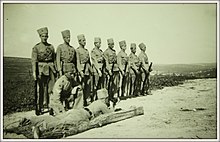Notrim

The Notrim (
Jewish units during the Arab Revolt (1936–39)
During the Arab revolt, the British Mandate authorities needed local manpower specifically to help with defending the borders of
As notrim thousands of young men had their first experience of military training, which Moshe Shertok and Eliyahu Golomb cited as one of the fruits of the Haganah's policy of havlagah (restraint).[5]

World War II
On 6 August 1940
Faced with
The Special Operations Executive in Cairo approved a Haganah proposal for guerilla activities in northern Palestine led by the Palmach, as part of which Yitzhak Sadeh devised "Plan North" for an armed enclave in the Carmel range from which the Yishuv could defend the region and attack Nazi communications and supply lines, if necessary.[6][dubious ] British intelligence also trained a small radio network under Moshe Dayan to act as spy cells in the event of a German invasion.[6][dubious ]

1945-48 and aftermath
The end of the Second World War in Europe marked a sharp political change in Mandate Palestine.
After
See also
References
Bibliography
- Brown, Nathan (April 1990). "Brigands and State Building: The Invention of Banditry in Modern Egypt". Comparative Studies in Society and History. 32 (2). Cambridge University Press: 258–281. S2CID 145501821. Retrieved 15 April 2021.
- Horowitz, Dan (1989). )
- Katz, Samuel (1988). Israeli Elite Units Since 1948. Vol. Text not accessible online. Osprey Publishing. p. 3. ISBN 978-0-85045-837-4. Retrieved 15 April 2021.
- Katzberg, Allan A. (1988). "Foundations Of Excellence: Moshe Dayan And Israel's Military Tradition (1880 To 1950)". Retrieved 15 April 2021.
- Penkower, Monty Noam (2002). Decision on Palestine Deferred: America, Britain and Wartime Diplomacy, 1939-1945. Israeli History, Politics, and Society. Vol. Text not accessible online. London: Routledge. pp. 112–113. ISBN 0-7146-5268-7. Retrieved 15 April 2021.
- ISBN 978-0-8047-3776-0. Retrieved 15 April 2021.
